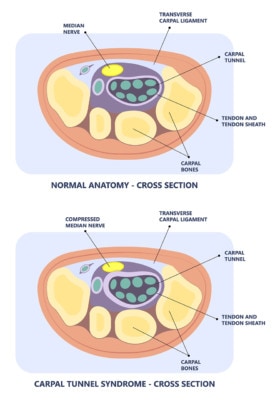Carpal Tunnel Steroid Injection: Is this Common Practice a Problem?

Rumruay/Shutterstock
Steroid injections are a 1950s remedy that are still surprisingly common in modern medicine. A carpal tunnel steroid injection is performed for patients who have carpal tunnel syndrome, or irritation or compression of the median nerve in the wrist. The injections seem to alleviate symptoms, but many different research studies have shown that the high dose steroids are bad news. For example, steroids are associated with dramatic increases in serious side effects like bone diseases as well as making musculoskeletal conditions like tennis elbow worse in the long run. A new study published this past quarter enters this fray by showing that a pre-operative carpal tunnel steroid injection hurt the long-term results from surgical release.
The authors out of eastern Europe reviewed the carpal tunnel surgery results of 174 hands (164 patients). The patients were interviewed by telephone 5-6 years after the operation. They were asked about the number of steroid injections received before the surgery, their improvement in symptoms (on a 100-point numeric rating scale), and if they had any remaining problems related to carpal tunnel syndrome. Just over half had complete resolution of their symptoms (53%). Each addition carpal tunnel steroid injection before surgery was associated with an increased risk of continued pain, tingling, and being awaken at night years after the surgery.
Why is this happening? High dose steroids are bad news. While this stuff is injected with wild abandon because it’s a potent anti-inflammatory, it’s also very toxic to local tissue and cells. In addition, the vast majority of carpal tunnel injections are performed blind, which is also not a good idea. It’s quite easy to hit the very superficial median nerve and inject toxic steroid into the nerve itself. IMHO, all of these carpal tunnel injections should be performed under ultrasound guidance so that the doctor can easily see the nerve and the needle and regrettably, this is rarely the case.
The upshot? A carpal tunnel steroid injection is bad news. While they can make a patient feel better short-term, like other steroid shots, they carry long-tern side effects. In addition, never let any physician inject into your carpal tunnel blind without guidance!

If you have questions or comments about this blog post, please email us at [email protected]
NOTE: This blog post provides general information to help the reader better understand regenerative medicine, musculoskeletal health, and related subjects. All content provided in this blog, website, or any linked materials, including text, graphics, images, patient profiles, outcomes, and information, are not intended and should not be considered or used as a substitute for medical advice, diagnosis, or treatment. Please always consult with a professional and certified healthcare provider to discuss if a treatment is right for you.
